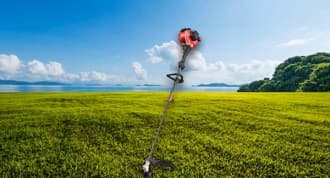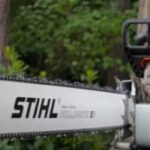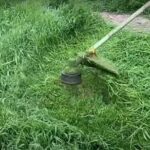As an Amazon Associate, this site earns commissions from qualifying purchases. For more information click here.
A string trimmer or weed whacker is a very useful tool, but how safe is it? Just like with any garden or outdoor equipment, knowing the safety guidelines and potential risks are essential. If you are worried about getting cut or hurt, this guide is for you.
The line on a string trimmer is very sharp and can cut through skin. You can also get injured by the rocks and other debris flying around you. For these reasons you should always wear goggles, gloves and thick pants when using a weed whacker.
Just to be clear, the terms string trimmer, weed eater and weed whacker refer to the same tool. They are used interchangeably
How a String Trimmer Can Cut You
There are two types of string trimmers: one that uses a blade, and the other a mono filament line attached to the trimmer head.
The danger posed by a blade-equipped trimmer is obvious. But even those without blades can cut you. That is why those will be the focus of this guide.
When you use a string trimmer, the throttle engages the trimmer head. The head is attached to a spool that releases sharp, fast moving lines (strings). These nylon lines can reach up to 8000 RPM and cut through weeds, grass and skin.
If your skin makes contact with the spinning line, you will get cut. But there are other ways you can get injured by a string trimmer.
Bruises and Scratches
String trimmers send rocks, weeds, sticks and other debris flying. If you are not wearing the right gear these objects can hit your knees and legs, causing bruises or scratches.
A single bruise or scratch is nothing serious, but if you are working on large, overgrown areas with lots of debris, you could get hurt.
To deal with these flying debris, manufacturers have equipped string trimmers with guards. These safety features are designed to block rocks and other flying objects from hitting your body.
While effective, the guard also limits the line you can use. This is why some people remove the guard and just wear thick pants, shoes and safety goggles.
There is a lot of debate whether you should remove trimmer guards or not. But for safety reasons manufacturers always recommend keeping the apparatus on.
Cuts
Cuts to the legs, ankles, hands and arms are usually the result of rocks, sticks, wood and other objects. As the line spins and cuts, debris fly all over. Some of these can hit you especially if the guard was removed.
These cuts can be avoided if you wear the right clothing. The guard can keep most of the debris away from you, but a few might get through. This is why wearing the right gear is important.

Eye and Head Injuries
Accidents involving the eyes and head are the worst. If a bit of sand got in your eye, it can be irritating. But if a wood splinter or small rock hit, the situation will be much worse.
What makes this really dangerous is the object comes flying right at you. The faster the trimmer line spines the faster it cuts. But that also means materials and debris fly all over quickly.
All sorts of injuries related to trimmers happen but those to the eye and head are the most serious. Scrapes on the knees, arms and legs you can recover from, but the eyes are a different story. To avoid permanent damage you have to wear the proper safety gear.
String Trimmer PPE Guide
The most effective way to avoid string trimmer injuries is to wear PPE (personal protective equipment). The most basic gear you should put on are safety goggles, long pants and long-sleeved shirt.
Face and Eye Protection
Ideally you should be covered from head to foot, but the most important PPE is for your eyes and face. Wear safety goggles or better yet a face shield. If you want full body and face protection, we suggest the Forester PPE.
You have probably seen some videos of people using a string trimmer without PPE. Do not take that chance. The threat to your eyes and face are real.
If you are working on a small area with few rocks, wood or other debris, safety goggles should be enough. But if it is overgrown with rocks, sand, plastic, etc. get a face shield.
Covering your eyes alone will not be enough. Rocks or pieces of wood flying could scratch your face if there is no protection.
Legs and Knees
The most basic protection are long pants. In most cases that should be enough to shield you from debris. You can also use leg chaps, guards and similar gear.
If you are only going to use long pants as protection, make sure it is made of thick material. Sharp rocks can rip through clothing so the fabric should be thick enough to protect your skin.
Hands and Feet
There are specially made gloves for string trimmers available like the Sleek Garden Gloves. They are thick but flexible so you won’t have trouble using the tool. You can wear other types of gloves as long as they cover your entire hand and you are comfortable.
Steel toe boots are the best for your feet. You could get away with regular shoes if you are trimming a small area. But if there are overgrown grass, weeds, rocks and other debris, boots are much better.
Wearing boots might seem too much, but you never know what object your trimmer might throw up. If a sharp or metallic object suddenly lands on your foot – or you hit one by accident – it can cause an injury. It is much better to be careful.
Other Ways to Protect Yourself
Wearing the right PPE is a step in the right direction. But there are other things that you have to do to avoid injuries and accidents. Just keep the following in mind and you should be safe out there.
Check the String Trimmer First
Make sure you cleaned the trimmer after its last use. If it is an electric model, check the cord and ensure it is plugged securely. If you are using a gas-powered weed whacker, be certain there is enough fuel in the tank.
If you have been using the trimmer for a while, you will notice any changes in its performance. If the engine does not sound right, the trimmer does not move like it should, there is not enough or too line coming out etc., turn the machine off. Find the source of the problem before resuming.
Clear the Area
If possible, clear out some of the debris before you start. It is impossible to remove all the rocks, sand and debris of course. But if you see plastic junk, metallic objects, pieces of wood and other stuff, remove as much as you can.
This might be tedious, but it reduces the chance of you getting hit by one of these things. It also makes the job easier for the trimmer. By getting rid of some of the debris, it becomes a safer place for you to do the work.
Wear your PPE before attempting to remove debris. There might be sharp objects around the area and you should always protect yourself.
Regular Cleaning and Maintenance
String trimmers need regular maintenance. This is particularly true for gas-powered models because of their engines.
Cleaning string trimmers is easy enough, and there are tools available for this. Pay close attention to the trimmer head and other places where dirt and debris can get stuck. The air filters have to be cleaned every few weeks and if damaged or too dirty, replaced.
The engine needs regular maintenance too. The major parts – carburetor, spark plug, fuel line, the primer bulb, etc. – have to be cleaned on a consistent basis. There are replacement parts available if necessary.
Inspect your PPE before and after use. Check your PPE before using it. Look for scratches or tears. Do the same for the safety goggles and face shield. After you are finished, check again.

I love the outdoors and all the tools for maintaining gardens, yards and lawns. The only thing I am more passionate about is sharing what I know about garden and outdoor equipment.


